|
The Rock Spring Nature Center is one of five
conservation areas in the Macon County Conservation District. At the
Center, hands-on learning experiences are offered through programs,
demonstrations, and workshops.
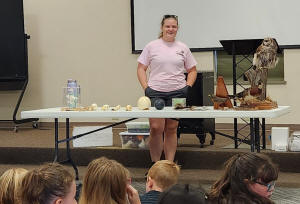
As Buley began the program, she asked the children
what makes a bird a bird? What makes it different from other
animals?
Children shouted out answers such as birds have feathers, beaks,
wings, and fly. Birds can be assorted colors and different sizes.
Some are nocturnal and see at night. Some go in the water. Some eat
meat and even snakes. Some have talons. Some birds are even trained
to be pets.
When birds flap their wings, many can lift themselves off the ground
and fly. Buley said birds can fly because their bones are hollow
making their bodies light. The bones have air pockets that look like
webbing.
If birds had bones like humans, Buley said they would not be able to
lift themselves off the ground.
The tail feathers and wing feathers help birds fly. Buley said they
also have fluffy feathers to help insulate their bodies and keep
them warm or cool. She showed a page with several different types of
bird feathers.

With assistance from intern Anna Sielaff, Buley
showed everyone replicas of a few birds. Buley said ducks have
something on their backs that puts out oil. The ducks take their
beaks and rub the oil onto their feathers to make them waterproof.
One replica was a wood duck. What is unique about wood ducks is that
they build their nests in trees and use their feet to perch on
branches. Buley said wood ducks lay their eggs in the trees. The
babies must jump out of the tree when they are little.
Penguins are another bird with an oil gland to help them waterproof
their bodies. Buley said their feathers are very tiny.
Many birds cannot waterproof their feathers. Therefore, Buley said
the birds get soaking wet when they dive in the water to catch fish.
When these birds stand with their wings out, the sun helps them dry
their wings.
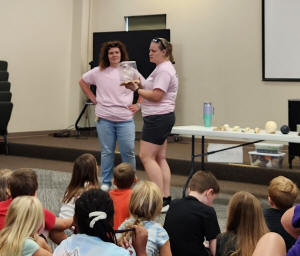
A replica of a pigeon skeleton had a keel hanging
down really far and sticking out from its chest. Buley said the keel
is where the pigeon’s muscles attach. The keel helps them fly and
move their wings around.
A sparrow’s nest Buley brought showed how birds weave materials
together, so they have a place to lay their eggs. Almost all birds
build some type of nest.

Large birds build large nests and tiny birds build
tiny nests. Buley showed an example of a tiny hummingbird nest
sitting on a branch. Buley said their nests are tiny because
hummingbirds are so tiny. Hummingbirds are great pollinators
spreading pollen to many different plants, so Buley said they are
helpful birds.

Samples of an ostrich egg and an emu egg were the
next items Buley showed everyone. Buley said ostriches are about
eight feet tall and emus about six feet tall, so they are the two
biggest birds in the world. Their large footprints look almost like
dinosaur footprints.

Ostriches and emus do not have very big wings and
cannot fly, which makes them different from many other birds.
Something Buley said ostriches and emus can do is run really fast
because of their long legs. Sielaff found information showing
ostriches can run nearly 40 miles per hour.
[to top of second column]
|

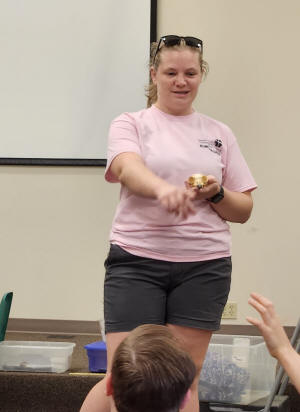
Buley brought several skull replicas of various birds
to show how different they look. One example was a replica of a
green horned owl skull with big eye sockets. Buley said owls can
turn their head 270 degrees to look to their left or right but
cannot move their eyes. However, owls can see well at night and fly
silently through the sky.
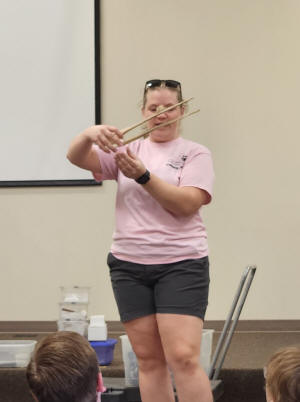
A pelican skull replica showed its long jaw. Buley
said a big pouch under the jaw is what pelicans use to catch fish.
Pelicans do not have teeth, so they just swallow their food whole.
The replica of an eagle’s skull showed its sharp beak. Buley said
eagles use their long beak to tear their food into smaller pieces.
A great blue herons’ skull replica had a pointy beak, which Buley
said they use to spear fish they will eat.
The replica of a woodpecker’s skull had a strong beak. Buley said
something unique about woodpeckers is that their tongue wraps around
in their skull to cushion its brains. This adaptation protects the
woodpecker’s head as it repeatedly pecks at trees to get bugs out.
One of the smallest skull replicas Buley showed everyone was from a
cardinal. Buley said cardinals use their strong beaks to break open
seeds, fruits, and nuts to eat. Sielaff told everyone the cardinal
is the state bird of Illinois.
The smallest skull replica was from a hummingbird. This skull was so
tiny, it was difficult to see when Buley was holding it. She
compared it to the size of a Q-tip.

A medium sized skull replica was from a goose. Buley
said geese and ducks have tiny saw-like teeth to filter food through
their mouths. As geese and ducks use their beaks to filter the food,
Buley said they can spit out what they do not want.
Birds are intelligent animals and Buley said they know what types of
trees to use. For example, Buley said there are some non-native pine
trees at the nature center and birds will go around these trees.
Birds also have many cool adaptations to help them survive in their
environments.
One example of an intelligent bird is a crow. Buley said crows can
use tools and recognize faces. Crows can pass information down
through four or five generations. If you are mean to a crow, the
crow is likely to remember your face and may teach their children
and grandchildren you are not a nice person. Years later, Buley said
the crow’s family may react negatively to you.
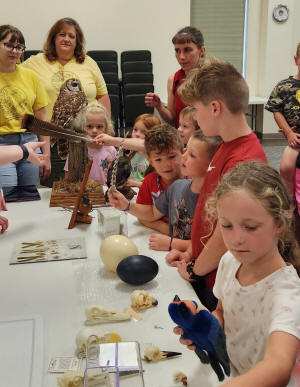
Once the program was over, children had the chance to
look more closely at the skull replicas and bird replicas, plus hold
a feather. Several children picked up stuffed birds that played the
sound the birds make.
Lincoln Public Library Youth Services Librarian Donna Cunningham
reminded the children to keep turning in their reading logs. July 24
will be the last day to turn in reading logs.
Next Thursday, July 20 at 10 a.m. is the final program for the
summer. Dino O’Dell will be sharing interactive songs and tall tales
to engage and entertain the audience. The program will be held in
one of the classrooms at Lincoln Christian Church. You can enter the
building under the canopy labeled section E right off the parking
lot.
[Angela Reiners] |